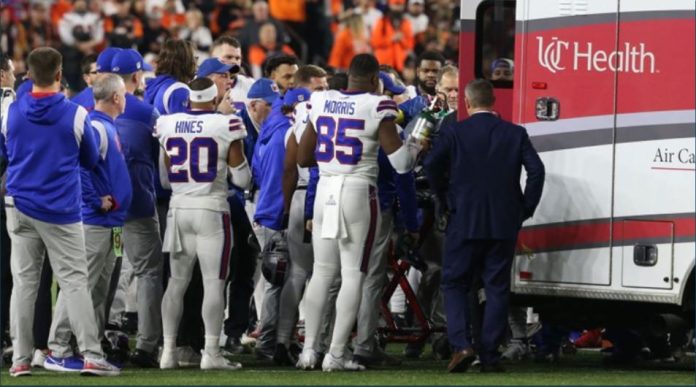Jan. 3 (UPI) — There is a broad spectrum of possibilities in what comes next for Buffalo Bills safety Damar Hamlin after he went into cardiac arrest following a blow to the chest in Monday night’s game against the Cincinnati Bengals, a highly experienced heart surgeon says.
“We’re all hoping he doesn’t have any [lasting] problems from this,” Dr. John Bozinovski, a cardiac surgeon at The Ohio State University Wexner Medical Center in Columbus, Ohio, told UPI by phone Tuesday.
Bozinovski, who did not treat Hamlin, but watched the game’s live telecast, said the aftermath, depending on the extent of injury, could range “from he walks out of the hospital to this being a fatal event.”
Whether Hamlin could play football again is a possibility, Bozinovski said, “but that’s not the important thing here. You’ve got a young man’s health and well-being” at stake.
In a statement early Tuesday morning, the Bills said the 24-year-old had suffered a cardiac arrest after a hit while making a tackle.
“His heartbeat was restored on the field and he was transferred to the University of Cincinnati Medical Center for further testing and treatment. He is currently sedated and listed in critical condition,” the statement said.
Hamlin received medical attention on the field for more than 10 minutes, with paramedics administering CPR and oxygen.
Having such expert help immediately on hand is a significant factor in Hamlin’s favor, as being a young man who is physiologically fit as a professional athlete, Bozinovski said.
Given these factors, and a professional sports team’s regular physicals and monitoring to address underlying health conditions, Bozinovski said he would expect a better outcome “in a random, by chance incident. In all likelihood, I suspect his heart was OK.”
But sometimes such problems are silent until an incident such as this arises, he said.
“Cardiac arrest” refers to a medical emergency that arises from the abrupt loss of heart function that causes a person’s sudden collapse. It usually stems from a problem with the heart’s electrical system that disrupts the heart’s pumping action and stops blood flow throughout the body.
The main cause of cardiac arrest is ventricular fibrillation or ventricular tachycardia, which are types of arrhythmias, or irregular heartbeats.
Cardiac arrest and myocardial infarction, known commonly as a heart attack, can occur in isolation or overlap.
With cardiac arrest, if you can’t re-establish blood flow almost immediately, within a few minutes, the heart could die.
“The sooner you can restore circulation after an event can have a big impact on overall function down the road,” Bozinovski said.
That calls for immediate treatment with CPR to circulate blood in the stricken person’s body until a defibrillator can be used. That’s an electronic device that sends an electric shock to the heart to try to wipe the slate clean and restore its normal rhythm.
“From my understanding, that’s what they were doing” on the field, Bozinovski said. “The sooner you can get attention, and the sooner someone can provide that CPR and get you to a defibrillator, the better.”
That’s because the brain and the heart are “exquisitely sensitive” to not having an adequate blood supply, he explained.
Bozinovski said you have “mere moments” to get blood back to the brain — “in a couple of minutes it can become catastrophic”; and a first responder has a couple of minutes to get blood back to the heart before myocardial infarction would occur.
“We have no idea how effective they were in restoring [Hamlin’s] circulation,” he said of the on-field medical assistance.
From what the cardiac surgeon saw of the hit, and the force of a shoulder into Hamlin’s chest, Hamlin was struck during “a vulnerable period of the cardiac cycle” when the heart is preparing for its next “firing,” the cardiac surgeon said. Hamlin initially stood, and then passed out likely because blood no longer was reaching his brain.
Now in the intensive care unit, “Our understanding is he was intubated with a protective airway, hooked up to a ventilator” — which means Hamlin “is not awake enough to protect his own airway,” Bozinovski said.
“They may be inducing a coma or he may’ve had a neurological insult,” Bozinovski said, and the ICU personnel would be supporting Hamlin with needed therapies depending on his level of heart, lung and brain function at this point.
“They’re supporting him with a ventilator and maybe other medications, as well,” from which medical personnel will have to wean him, he said.
Cardiac arrest causes about 300,000 to 450,000 deaths in the United States annually, according to the National Heart, Lung, and Blood Institute, a part of the National Institutes of Health.
Nine out of 10 people who have a cardiac arrest outside of a hospital die — often within minutes, the institute says.







